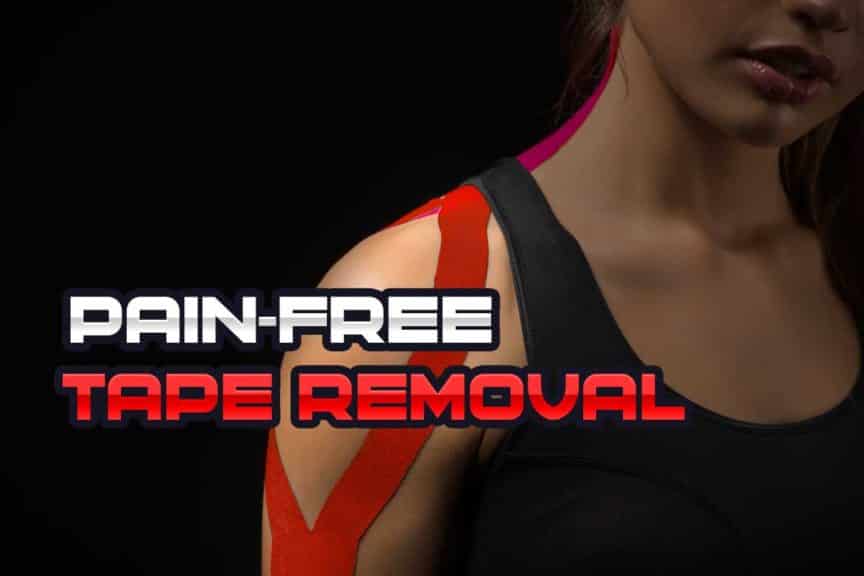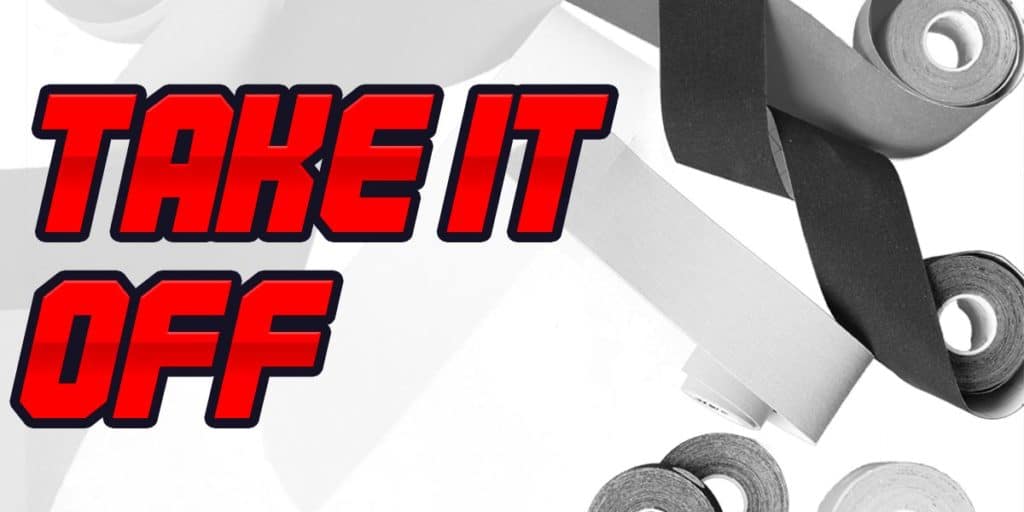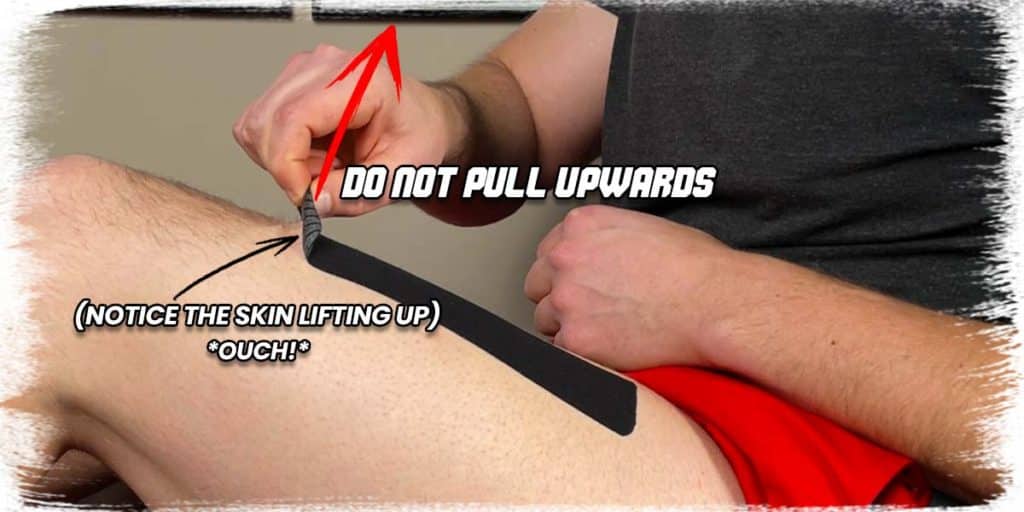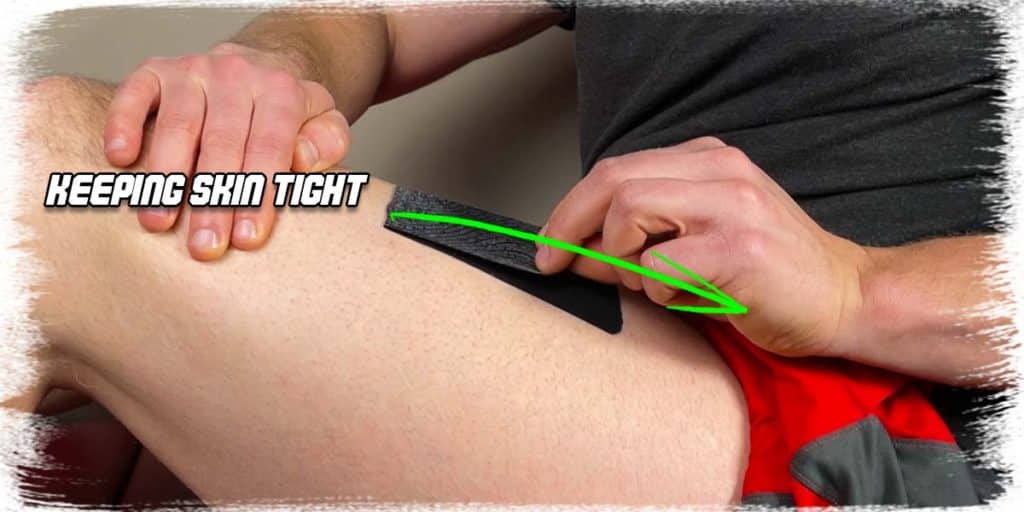Sports tape can be a pretty fantastic product and one that is your best friend…until it comes time to take it off. At this point, it often somehow instantly becomes your worst enemy; the pain of peeling the tape off of your skin can be rather brutal, especially if you have sensitive skin. Thankfully, this article will provide you with some exceptionally effective tips that will help make the tape-removal process way more manageable and WAY less painful.
Want the quick rundown on how to make this happen? Here’s the short answer:
To remove sports tape without pain, keep the skin taut when peeling the tape back and peel the tape back horizontally to your skin. If this is still painful, soak the area in warm water or with a warm washcloth or rub baby oil or vegetable oil on top of the tape to lessen its adhesive strength.
These tips are effective for all types of sports tape, such as kinesiology tape (KT tape), white athletic tape, Leukotape, cover roll, or any other adhesive-based tape applied to your skin.
If you perform the above steps, you’ll very likely experience a significantly lower amount of pain when it comes to removing your tape. Now, if you want a bit more of the specifics with these steps or are curious as to why this tends to be such an effective approach, then keep on reading!
ARTICLE OVERVIEW (Quick Links)
Click/tap on any of the following headlines to instantly jump to that section of the article!
• Tip 1: Keep the skin taut when peeling
• Tip 2: Peel horizontal to the skin
• Tip 3: Soak the area
• Tip 4: Use baby oil or vegetable oil
• Tip 5: Heat the area using dry heat
• Bonus tip: Next time, use THIS specific tape
Related article: Seven Easy Ways For Making Kinesiology Tape Stick WAY Better
Tip 1: Keep the skin taut when peeling
The whole process of removing your sports tape while minimizing the potential for discomfort begins with using your free hand to keep your skin taut throughout the entire peeling process. Furthermore, this tip should be used while employing any of the following four tips as well (especially with the second tip, as you might not always need to use tips 3 or 4).
If you don’t hold keep your skin taut by holding it down when peeling off your tape, your skin will undergo a much greater amount of stretch, which will likely be much more uncomfortable.
The more you can minimize the skin from moving and stretching, the less painful the tape-removal process will be.
Pro tip: If you’re trying to remove the tape by yourself, and it’s on an area of your body where you can’t effectively keep the skin tight or held down on your own, see if you can get a friend or family member to either hold your skin tight while you peel the tape away, or have them peel the tape while you hold your skin tight.
Tip 2: Peel horizontal to the skin
If you didn’t read tip #1, be sure to do so, as this tip goes hand-in-hand with that one whenever peeling off your tape.
The biggest mistake you can make when peeling tape off of your skin is to peel the tape while keeping it near perpendicular to your skin. The more perpendicular it is, the more it can pull and tug the skin.
The key here is to pull the tape entirely backwards, keeping it parallel with your skin. This will prevent the skin from lifting upwards, significantly reducing the overall discomfort you’ll feel on your skin.
If you peel the tape straight back while keeping your skin taught (tip 4), you’ll dramatically reduce the amount of discomfort and irritation that your skin experiences when the tape is being removed.
Tip 3: Soak the area
This tip tends to work best for:
kinesiology tape and standard athletic tape. It may be enough to make the removal process pain-free; however, you might also need to use additional steps.
Warm water works best when it comes to soaking your sports tape. Depending on where the tape has been applied to your body, you may opt to drape a warm washcloth on top of the tape rather than try to submerge it completely.
You’ll likely want to let the tape and skin soak for anywhere between five to ten minutes, preferably with water as warm/hot as you can safely tolerate without running the risk of burning your skin. Soaking in a bathtub or spending an extra minute or two in the shower are good strategies for this.
Depending on the type of sports tape fastened to your skin, this may work relatively well or not as well as you’d like. Once you’ve soaked the area for around ten minutes, see if the tape is any easier to now peel off. If it isn’t, consider moving on to the following tips below.
Tip 4: Use baby oil or vegetable oil
If soaking the area isn’t your thing, or you’re still finding the tape to be too sticky/painful to remove, using baby oil or vegetable/cooking oil might be worth a shot. In my experience, either will work fine, so just grab whichever you may have on hand. Next, slather it on top of the tape you’d like to remove.
This tip tends to work very well for Kinesio tape, cover roll/Hypafix, standard athletic tape and Leukotape.
Why are we doing this? Well, the oil, when it soaks through the tape, it interacts with the adhesive and ultimately helps to disrupt its ability to stick to the skin. This makes the tape much less sticky (and thus, painful) to remove.
You’ll want to really slather (and then rub) on the oil to ensure it really soaks into the tape. From there, let it soak into the tape for anywhere between five to fifteen minutes to ensure that the oil really has a chance to soak through the tape and interact/interfere with the tape’s adhesive.
Then, as you peel the tape off, ensure that you incorporate keep your skin taut while pulling the tape parallel to the skin (tips 1 & 2).
Pro tip: To ensure that the oil soaks through as much as possible and interacts with the adhesive to a maximal extent, rub your hand over the tape continuously for a couple of minutes to further drive the oil through the tape.
Tip 5: Heat the area using dry heat
If (for whatever reason) you can’t soak the area or don’t have any baby oil or cooking oil on hand to use, you can try heating the targeted area with dry heat, such as from a heating pad or a hairdryer.
Heat (of any kind) can help to reduce the effectiveness of the tape’s adhesion, making it much easier and less painful to remove. You’ll likely need to heat up the area for a handful of minutes (anywhere from five to fifteen, depending on how you’re heating it). As with Tip 1, just make sure you don’t burn your skin.
A hairdryer or a heating pad can work quite well for this, depending on the area of your body that you’re trying to remove the tape from; use a heating source that is most appropriate or ideal for you.
Bonus tip: Next time, use THIS specific tape
If you find that standard Kinesio tape is just a bit too irritating for your skin when it comes to wearing or removing it, you may want to try a specific type of Kinesio tape designed for sensitive skin.
Many different companies offer this specialized version of tape. Still, the one that I’d likely recommend (in terms of familiarity with the brand, its pricing and quality) is this specific roll by Spider Tech (link takes you to Amazon).
Please note: The above link is an affiliate link and I earn a small commission at no extra cost to you if you make a purchase through it. I use these small bits of revenue to help offset the cost of running this site.
There are plenty of other quality brands that offer similar features, so don’t be afraid to look around; the Spider Tech roll is what I’d recommend as I believe they make some high-quality tape AND it’s priced quite reasonably. They also usually have quite a selection of tape colours and styles to choose from.
Related Article: Six Benefits Of Using An Acupressure Mat For Your Aches And Pains
Final thoughts
Sports tape can make a significant difference when it comes to decreasing pain and helping to improve performance. But it can also be a considerable nuisance to remove, both in terms of difficulty and accompanying pain.
Give the tips within this article a try and use them as needed to make life a lot easier and much less painful when trying to remove your sports tape. Your skin (and the pain receptors within it) will thank you for doing so!

Hi! I’m Jim Wittstrom, PT, DPT, CSCS, Pn1.
I am a physical therapist who is passionate about all things pertaining to strength & conditioning, human movement, injury prevention and rehabilitation. I created StrengthResurgence.com in order to help others become stronger and healthier. I also love helping aspiring students and therapists fulfill their dreams of becoming successful in school and within their clinical PT practice. Thanks for checking out my site!




